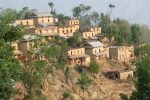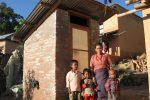A village based sanitation program
For 20 years the villagers of Bhattedande, trying to improve the sanitation in their village and their living standards, had experienced raised hopes and then disappointment from broken promises – by Government agencies, NGOs and others who said they would provide programs but delivered nothing.
After TT established a dental program in the school and improved the sanitation there, the village sanitation program in Bhattedande was developed in partnership with the village development committee, Community Health Development Society Nepal (CHDS), Paul Pholeros from Healthabitat, and Rotary Australia (Rotary Club of Dee Why Warringah and RAWCS).
The toilet systems are either septic or biogas systems, one per household. A biogas system is installed where the house has enough land to accommodate the underground gas digester dome, and the owner has at least one large animal such as a cow or buffalo to help generate the minimum 25-30 kg waste required to produce 2 hours of cooking gas in the house. If not then a 2-chamber septic treatment system is installed.
Each toilet building is equipped with a 500 litre rainwater collection tank to enable rainwater harvesting in the monsoon times, and to improve water storage in the drier months.
Householders receive training in the management and maintenance of the systems, and local teams are trained to inspect and monitor the functioning of the units. Formal education sessions are provided on hand washing and hygiene, and toothbrushing.
All the work is managed and done by local village teams and the program has now been completed in two more villages, Arubot and Dandagaun.
Examples of the sanitation reports provided to donors:



